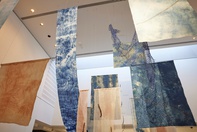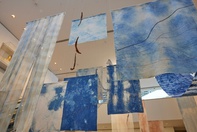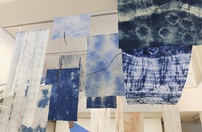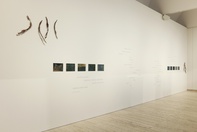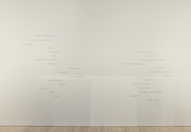Judy Watson
Jagera/Turrbal Country, Meanjin (Brisbane). Waanyi, Gulf region
2021
Displayed 2021 at Art Gallery of New South Wales

Judy Watson
Born 1959, Goreng Goreng Country, Munduberra, Queensland. Lives and works on Jagera/Turrbal Country, Meanjin (Brisbane). Waanyi, Gulf region
Judy Watson’s Aboriginal matrilineal family is from Waanyi Country in north-west Queensland. Spanning the mediums of painting, printmaking, drawing, sculpture, video and installation, her practice sometimes draws on archival documents and materials, such as maps, letters and police reports, to unveil institutionalised discrimination against Aboriginal people. Often using natural materials found in situ, Watson impresses textures into her canvases and allows their contours to form a blueprint for the pigments pooling on it. The artist’s process evolves by working from site and memory, revealing Indigenous histories, following lines of emotional and physical topography that centre on particular places and moments in time.
Judy Watson and her family provide an insight into her work in Waanyi language in the following text.
|
jala dayi kundana. mudunama nundan wandaraba jarribirri kiji kuluu. waanyi biijbi banja. – Otis Carmichael |
now the tree is cut. tomorrow the tree grows stronger, fighting the axe that cut it. our people bite back. – Otis Carmichael |
|
manku jiringkijbi nurriyanya waanyi story maka-nijbi mirramba nirriyanya jalwamba. jilaba maramaramba bulwa nanagkuya kudawudanngirri makarraba bulangi kunju bulinjaa, nanajba. najba-najba. – Lisa Watson |
listening, hearing, learning, knowing our Waanyi true (put straight) story, makes us strong. Moving quietly through the water those two girls cover their body with weeds, waiting. Watch out. – Lisa Watson |
|
kingkarri balana, kingkarri madarrini kayangka. – Judy Watson |
high up in the sky above the clouds move through air. – Judy Watson |
|
ngada. nawi. badada. nawi. jangu. kundi. wadaba. ara. kaku. jukuli. malumalu. yanja. bujimala – Joyce Watson |
mother. father. baby. husband. fire. house. goanna. dog. fish. boomerang. mussel. big waterhole. rainbow snake – Joyce Watson |
Artist text
by Cara Pinchbeck
In her text ‘the meaning of blue’ from 2020, Judy Watson begins:
blue is the colour of memory
the colour of water and sky
translucent and dense
dark beyond black
velvety
soft and porous
For Watson blue is not simply a colour, but a precious resource, a reminder of time and place, a marker of memories both distant and recent that overlap and merge like pigment pooling on canvas. Blue has been employed by Watson throughout her practice and is the predominant colour in her installation clouds and undercurrents (2021). These suspended canvases, layered and floating in space, create a canopy overhead, a skyscape in which plumes of white are reminiscent of clouds in an indigo sky. Crease-like filaments of darkened blue crisscross many works, forming an immense network of connections both seen and implied. Restrained pops of ochre contrast with blue, intensifying both colours and offering a reminder of the ground below and the undercurrents that feed Country.
Dumularra is the Waanyi word for running water and Watson has spoken of Waanyi being known as running water people given the prevalence of water in their Gulf Country. However, in recent years people have noticed a dramatic decrease in freshwater springs, with some suggesting up to 80 per cent have disappeared. (1) It is thought that this is due to the impacts of bores for mining and introduced agriculture on subterranean water that had filtered through the limestone plateau to nourish Country and its people for millennia.
In Sydney the freshwater of what became known as the Tank Stream was vital within Gadigal Country, flowing from swamps between today’s Hyde Park and Sydney Town Hall, down waterfalls near Bridge Street to the waters of Warrane (Sydney Cove). The stream provided the freshwater essential to the survival of the new arrivals. However, their subsequent excavations to create tanks, followed by pollution from people and pigsties, led to it becoming an open sewer by 1828. Today the stream is not evident above ground, but it continues to seep beneath Sydney streets. Watson has walked its underground tunnels and worked with Greg Hooper to capture the sound of water that flows with the memory of times past.
The falling canvases in clouds and undercurrents evoke images of the former waterfalls of the Tank Stream that cascaded for generations. Watson alerts us to the current state of the stream through the audio within the space – a gentle trickle that attempts to maintain its previous path. The sound of water gliding over rocks in Waanyi Country can also be heard, followed by the calls of birds. Changes to water are detrimental to all living beings, including Country. A decrease in groundwater leads to increased salinisation and areas of raw canvas may remind some of this. Others may see references to limestone, or rain-bearing clouds that result from water rising indiscernibly into the sky.
Watson offers us touchpoints that prompt greater consideration of water, and the environment more generally. Evidence-based graphs by scientists warning of the need for change, sewn on to works by her cousin Dot Watson, appear scar-like crosscutting the flow of water. Is it an everlasting marker of damage, or is it a line of mending where a fault has been repaired? Knowledge of water and its connection to people and place is immense, and Watson reveals the potential that may be found by listening to Aboriginal people through the numerous Waanyi words for water in the work. Perhaps now is the time for wider Australia to listen, learn and care more deeply. There is nothing to lose, but potentially much to gain.
(1) Judy Watson artist talk, Artspace, Sydney, 20 Jan 2021, at artspace.org.au/program/public-programs/2021/carol-mcgregor-and-judy-watson-in-conversation-with-wesley-enoch/, accessed 8 Mar 2021.
Artist's acknowledgements
This project has been assisted by the Australian Government through the Australia Council for the Arts, its arts funding and advisory body.
Atelier, the next generation of philanthropy at the AGNSW, proudly support Judy Watson as philanthropy partner.
Collaborators: Otis Carmichael, Dhana Merritt, Dot Watson, Lisa Watson, Joyce Watson
Sound: Greg Hooper
